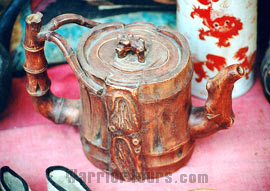Chinese Tea
According to Lu Yu, the writer of the book Tea Classics in the Tang Dynasty (618 --- 907), Chinese tea enjoyed a more than 4000 years history.
Tea was used as offerings in the Western Zhou Dynasty (11th century BC --- 711 BC), vegetables in the Spring and Autumn Period (770 BC - 476 BC), and medicine in the Warring States Period (476 BC - 221 BC). Later in the Western Han Dynasty (206 BC - 24 AD), it became a main commodity. During 300 years between the Three Kingdoms Period (220 - 280) and the Northern and Southern Dynasties (386 --- 589), especially the latter, Buddhism was popular and Buddhists applied tea to relieve sleep in za-zen, so tea trees were planted around temples. That is why people say tea and Buddhism accompanied each other in their development. Till the Tang Dynasty tea became popular among ordinary people. In the Ming Dynasty (1368 --- 1644), tea trade began to play an important role in the government economy, the 'Tea and Horse Bureau' was set up to supervise the tea trade.
 In the 6th century, a Buddhist monk introduced tea to Japan and in the 16th century to Europe by a Portuguese missionary. And tea became an international drink.
In the 6th century, a Buddhist monk introduced tea to Japan and in the 16th century to Europe by a Portuguese missionary. And tea became an international drink.
Now in China, tea family also includes beverage, food, medicine and other products.
![]() Top Ten Chinese Tea
Top Ten Chinese Tea
![]() Tea wares
Tea wares
![]() Tea culture
Tea culture
![]() Tea classification
Tea classification
Although there are hundreds of varieties of Chinese tea, they can be mainly classified into five categories, that is, green tea, black tea, brick tea, scented tea, and Oolong tea.
With its natural fragrance, green tea, as the oldest kind of tea, is widely welcomed by different people. It is baked immediately after picking. According to the different ways of processing, it can be divided to many kinds. Among various green tea, Longjing (Dragon Well) Tea around the West Lake in Hangzhou, HuangshanMaofeng Tea from Mt. Huangshan, Yinzhen (Silver Needle) Tea from Mt. Junshan and Yunwu (Cloud and Mist) Tea from Mt. Lushan are most famous.
 Black tea is much more favored by foreigners. Different from green tea, black tea is a kind of fermented tea. After the fermentation, its color changes from green to black. The most famous black teas in China are 'Qi Hong (originated in Anhui)', 'Dian Hong' (originated in Yunnan), and 'Ying Hong' (originated in Guangdong).
Black tea is much more favored by foreigners. Different from green tea, black tea is a kind of fermented tea. After the fermentation, its color changes from green to black. The most famous black teas in China are 'Qi Hong (originated in Anhui)', 'Dian Hong' (originated in Yunnan), and 'Ying Hong' (originated in Guangdong).
Oolong tea, with an excellent combination of the freshness of green tea and the fragrance of black tea, become popular with more and more people. It has a good function in helping body building and dieting. Fujian, Guangdong and Taiwan are the major producing areas of this kind of tea. Oolong tea grows on cliffs, the hard picking process make it the most precious tea.
Scented tea, which is very popular in Northern China, in fact is a mixture of green tea with flower petals of rose, jasmine, orchid and plum through an elaborate process. Among this type, jasmine tea is common.
Brick tea, usually pressed into brick shape, is mainly produced in Hunan, Hubei, Sichuan, Yunnan and Guangxi Zhuang Autonomous Region. Brick tea is made from black tea or green tea and is pressed into blocks. This kind of tea is popular with minority people in border regions. The most famous one is 'Pu'er Tea' made in Yunnan province.
There are other kinds of tea. Among them white tea is special and is not very familiar to most people. Just as its name suggests, this kind of tea is as white as silver. It is mainly produced in Zhenhe and Fuding in Fujian Province, but popular in Southeast Asia. Famous varieties include "Silver Needle" and 'White Peony'.

